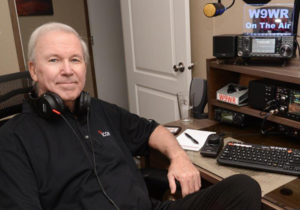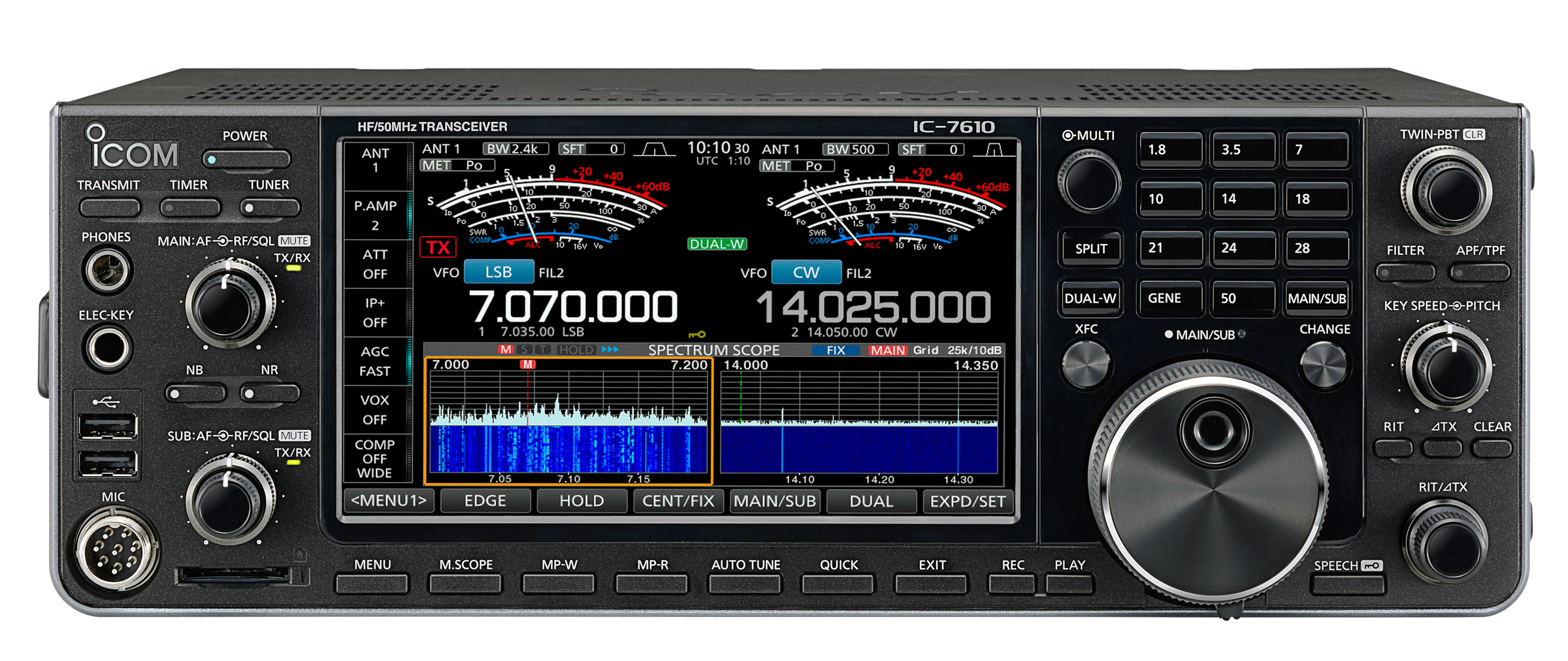When it comes to Amateur Radio, I am an HF “meat and potatoes” guy. When I was first licensed in the mid-sixties CW and “phone”-along with some RTTY, was the “main event” for most.
We each have our favorite modes. Mine has always been CW. I see it as a language fluency–an art form, if you will.
CW is still my personal preference. Using this mode, I enjoy random QSO’s “rag chewing” with like-minded acquaintances and new friends about various topics such as family, geography, weather and the like. I also like chasing DX as well, and will switch to S SB on six meters to increase my grid square count.
When the time came to choose a new HF/6 Meter transceiver, I did my homework-deciding on the new Icom IC-7610.
I am now happier than ever with my choice of the Icom IC-7610! From the day I unboxed it to months later, as I use it (nearly every day!) I am happier than ever that I chose this brand and this model. For one thing, the very roots of Icom as a company were found in the owner and founders love of amateur radio. His commitment and those of the team he has built continue to this day–both at Icom America and at Icom world HQ! That speaks volumes to me! And over the years, I have owned a number of Icoms in my shack as I pursued DX (IC-735) chased contest awards (IC-765, IC-7800), had a blast with QRP (IC-703) and ran mobile SSB, FM and CW (IC-706MKIIG). Looking back, Icom has been my constant RF companion each step of the way!
So when I spoke with friends about their IC-7600’s I was really excited when Icom announced the IC-7610 as the industry’s first-in-class mid level stand alone SDR. I figured that as wildly popular as the IC-7300 has been, at the enhanced next level of like-design, the IC-7610 would be top rated as well.
I don’t think the delivery truck cleared the driveway before I had slit open the sturdy box and lifted this shiny new beauty out of the carton and unfurled the plastic surrounding it! To see the ad pictures in the radio magazines is one thing but when I sat the new rig on my shack desk for the first time, I was taken aback–this radio is simply beautiful! If that wasn’t enough, when I powered up the IC-7610 and the 7” display came alive, I found it to be stunning!
Looks is one thing, but the functionality and performance is yet another. It was like this radio was reading my mind. If I needed anything, I found it logically shown on the display and in multiple colors. I couldn’t take my eyes off of it at first, but finally did, so I had to hear this new rig! I have what most consider being a nice antenna farm (I run my IC-9100 very effectively on multi mode VHF and UHF monoband antennas). And now, I would put the IC-7610 to the test on my 80 Meter loop and tribander–both at modest heights. The basic shack connections were made in moments.
The radio came to life.

What immediately was noticeable was how very quiet the 7610’s receiver is. As I tuned slowly across 20 Meters, signals seemed to leap out of a very quiet noise floor! A transceiver is defined by the effectiveness of its receiver performance. In the old days, a common saying was “if you can’t hear ‘em you cannot work ‘em”….so true!
Using a well-designed rig over a weekend is like taking a long trip in a very nice car; you appreciate its quality and its design fine points more than ever! During my first weekend on the air with my Icom 7610, I was not disappointed! I immediately appreciated the radios internal speaker, which rivaled the performance of many an external speaker that I had tried over the years. Icom’s engineers put a lot of thought into its design, which was evidenced by its rich, full sound. It sounded worthy of the radio that I was fast becoming enamored with!
On Saturday, I was tuning on the 17-meter CW sub-band when I saw a beehive of activity about 10 kHz higher than where I was listening. A touch of the IC-7610’s display screen immediately took me to a DX-peditions frequency. The station was in the South Pacific, and due to conditions and the limitations of my humble HF antenna system, I was struggling to hear them. I had heard about the IC-7610’s APF (Audio Peak Filter) feature, so with nothing to lose, I pushed the button. I was astounded. The station rose up out of the band’s noise floor and morphed from being barely copyable to being easily heard. And this occurred with the factory default settings. I had not even optimized this filter to my ears via the menu!
Making my call, I put the radios CW full break-in (QSK) feature to the test. It was smooth as can be, virtually silent to my ears with a beautiful T/R turn around time that I first enjoyed in the fantastic IC-781 from back in the 1980s.
As if this wasn’t all good enough, my new IC-7610 provided me with an added treat that Saturday morning, as I put this new ATNO (all time new one) in my log for another notch on my DXCC belt. Six meters had come alive on my new rigs second VFO. It was on the 50.125 USB voice calling channel! And at a glance, I could tell that there were all kinds of activity on six across the spectrum, with a moment’s glance at my sub-receiver’s spectrum scope.
I quickly put three new grid squares in my log. Satisfaction!
After lunch I had some other things to do. As it was, I had a quick sandwich in the shack, before leaving for a ball game with my daughter Lauren and my grandsons. I must admit, at halftime, my thoughts were of spending more time that weekend with this new beauty in my shack.
This radio was a real value to me when I made the decision to spend my hard-earned money on it. And to this day I am glad I did! I cannot imagine outgrowing it. I am already looking forward to more contests, rag chews and adding to my DXCC and grid counts!
And most fun of all, I will be pleased and proud to host my buddies who have heard about my new Icom IC-7610. I think we will be using it as our main rig next Field Day!
What a hobby!
Check out the IC-7610 product page to learn more.


